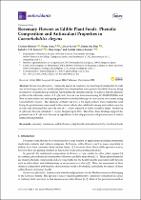Por favor, use este identificador para citar o enlazar este ítem:
https://repositorio.usj.es/handle/123456789/448
Registro completo de metadatos
| Campo DC | Valor | Lengua/Idioma |
|---|---|---|
| dc.contributor.author | Moliner Langa, Ana Cristina | - |
| dc.contributor.author | López Ramos, Víctor | - |
| dc.contributor.author | Barros, Lillian | - |
| dc.contributor.author | Dias, Maria Inês | - |
| dc.contributor.author | Ferreira, Isabel C. F. R | - |
| dc.contributor.author | Langa Morales, Elisa | - |
| dc.contributor.author | Gómez-Rincón, Carlota | - |
| dc.date.accessioned | 2021-02-09T11:43:20Z | - |
| dc.date.available | 2021-02-09T11:43:20Z | - |
| dc.date.issued | 2020-09-01 | - |
| dc.identifier.citation | Moliner, C., López, V., Barros, L., Dias, M. I., Ferreira, I. C. F. R., Langa, E., & Gómez-Rincón, C. (2020). Rosemary flowers as edible plant foods: Phenolic composition and antioxidant properties in caenorhabditis elegans. Antioxidants, 9(9), 1-11. doi:10.3390/antiox9090811 | es_ES |
| dc.identifier.issn | 2076-3921 | es_ES |
| dc.identifier.uri | https://repositorio.usj.es/handle/123456789/448 | - |
| dc.description.abstract | Rosmarinus officinalis L., commonly known as rosemary, has been largely studied for its wide use as food ingredient and medicinal plant; less attention has been given to its edible flowers, being necessary to evaluate their potential as functional foods or nutraceuticals. To achieve that, the phenolic profile of the ethanolic extract of R. officinalis flowers was determined using LC-DAD-ESI/MSn and then its antioxidant and anti-ageing potential was studied through in vitro and in vivo assays using Caenorhabditis elegans. The phenolic content was 14.3 ± 0.1 mg/g extract, trans rosmarinic acid being the predominant compound in the extract, which also exhibited a strong antioxidant capacity in vitro and increased the survival rate of C. elegans exposed to lethal oxidative stress. Moreover, R. officinalis flowers extended C. elegans lifespan up to 18%. Therefore, these findings support the potential use of R. officinalis flowers as ingredients to develop products with pharmaceutical and/or nutraceutical potential. | es_ES |
| dc.format.extent | 11 p. | es_ES |
| dc.format.mimetype | application/pdf | es_ES |
| dc.language.iso | eng | es_ES |
| dc.publisher | MDPI | es_ES |
| dc.relation | Acknowledgments: Universidad San Jorge is acknowledged for financial support and providing Cristina Moliner with a PhD scholarship. The authors are grateful to the Foundation for Science and Technology (FCT, Portugal) for financial support through national funds FCT/MCTES to CIMO (UIDB/00690/2020). National funding was provided by FCT, P.I., through the institutional scientific employment program-contract for M.I. Dias’ and L. Barros’ contracts. The authors are also grateful to the FEDER-Interreg España-Portugal programme for financial support through the project 0377_Iberphenol_6_E and 0612_TRANS_CO_LAB_2_P. | es_ES |
| dc.rights | Atribución 4.0 Internacional | * |
| dc.rights.uri | http://creativecommons.org/licenses/by/4.0/ | * |
| dc.subject | Romero | es_ES |
| dc.subject | Flores comestibles | es_ES |
| dc.subject | Polifenoles | es_ES |
| dc.subject | Actividad antioxidante | es_ES |
| dc.subject | Alimentos funcionales | es_ES |
| dc.title | Rosemary flowers as edible plant foods: Phenolic composition and antioxidant properties in caenorhabditis elegans | es_ES |
| dc.type | info:eu-repo/semantics/article | es_ES |
| dc.subject.unesco | Flor | es_ES |
| dc.identifier.doi | 10.3390/antiox909081 | es_ES |
| dc.rights.accessrights | info:eu-repo/semantics/openAccess | es_ES |
| Aparece en las colecciones: | Artículos de revistas | |
Ficheros en este ítem:
| Fichero | Descripción | Tamaño | Formato | |
|---|---|---|---|---|
| Rosemary flowers as edible plant foods.pdf | 838,58 kB | Adobe PDF |  Visualizar/Abrir |
Este ítem está sujeto a una licencia Creative Commons Licencia Creative Commons

